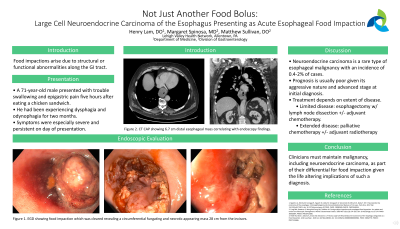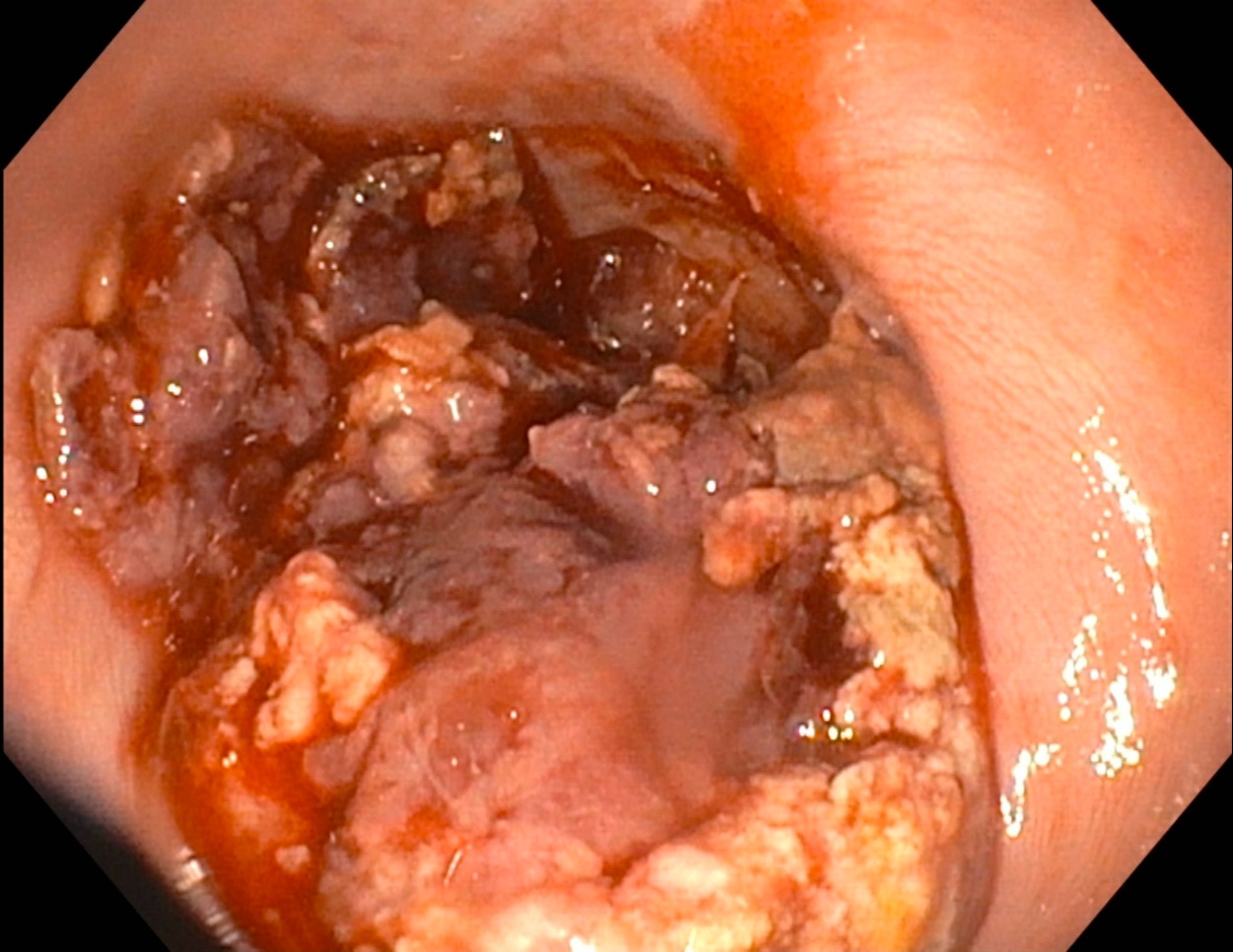Back


Poster Session E - Tuesday Afternoon
Category: Esophagus
E0212 - Not Just Another Food Bolus: Large Cell Neuroendocrine Carcinoma of the Esophagus Presenting as Acute Esophageal Food Impaction
Tuesday, October 25, 2022
3:00 PM – 5:00 PM ET
Location: Crown Ballroom

Has Audio

Henry Lam, DO
Lehigh Valley Health Network
Allentown, PA
Presenting Author(s)
Henry Lam, DO1, Margaret Spinosa, MD1, Matthew J. Sullivan, DO2
1Lehigh Valley Health Network, Allentown, PA; 2Eastern Pennsylvania Gastroenterology and Liver Specialists, Allentown, PA
Introduction: Food impactions arise due to structural or functional abnormalities along the GI tract most commonly at the esophagus. The differential diagnosis is broad but importantly includes malignancy. Here we highlight a rare case of food impaction secondary to high-grade neuroendocrine carcinoma.
Case Description/Methods: A 71-year-old male with a history of asthma presented with trouble swallowing and epigastric pain five hours after eating a chicken sandwich. He had been experiencing dysphagia and odynophagia for the past two months, but symptoms were especially severe on day of presentation to the point that he was unable to eat or drink anything afterwards given persistent regurgitation. Urgent EGD showed a food impaction of the distal esophagus, which was successfully removed through suction cap revealing a circumferential fungating and necrotic appearing mass at 28 cm from the incisors. Biopsies were obtained, but the mass could not be traversed. Subsequent CT CAP showed a 6.7 cm distal esophageal mass correlating with endoscopic findings as well as nonregional lymphadenopathy concerning for metastatic disease. Pathology unfortunately revealed high-grade neuroendocrine carcinoma WHO grade 3 with small and large cell features. Patient was deemed not a surgical candidate given metastatic disease and was started on palliative chemotherapy.
Discussion: Neuroendocrine carcinoma is a rare type of esophageal malignancy with an incidence of 0.4-2% of cases. Prognosis is usually poor given its aggressive nature and advanced stage at initial diagnosis. Treatment depends on the extent of disease. For those with limited disease, esophagectomy with lymph node dissection +/- adjuvant chemotherapy is warranted. On the other hand, extended disease relies upon palliative chemotherapy +/- adjuvant radiotherapy. Clinicians must maintain neuroendocrine carcinoma as part of their differential for food impaction given the life-altering implications that such a diagnosis holds.

Disclosures:
Henry Lam, DO1, Margaret Spinosa, MD1, Matthew J. Sullivan, DO2. E0212 - Not Just Another Food Bolus: Large Cell Neuroendocrine Carcinoma of the Esophagus Presenting as Acute Esophageal Food Impaction, ACG 2022 Annual Scientific Meeting Abstracts. Charlotte, NC: American College of Gastroenterology.
1Lehigh Valley Health Network, Allentown, PA; 2Eastern Pennsylvania Gastroenterology and Liver Specialists, Allentown, PA
Introduction: Food impactions arise due to structural or functional abnormalities along the GI tract most commonly at the esophagus. The differential diagnosis is broad but importantly includes malignancy. Here we highlight a rare case of food impaction secondary to high-grade neuroendocrine carcinoma.
Case Description/Methods: A 71-year-old male with a history of asthma presented with trouble swallowing and epigastric pain five hours after eating a chicken sandwich. He had been experiencing dysphagia and odynophagia for the past two months, but symptoms were especially severe on day of presentation to the point that he was unable to eat or drink anything afterwards given persistent regurgitation. Urgent EGD showed a food impaction of the distal esophagus, which was successfully removed through suction cap revealing a circumferential fungating and necrotic appearing mass at 28 cm from the incisors. Biopsies were obtained, but the mass could not be traversed. Subsequent CT CAP showed a 6.7 cm distal esophageal mass correlating with endoscopic findings as well as nonregional lymphadenopathy concerning for metastatic disease. Pathology unfortunately revealed high-grade neuroendocrine carcinoma WHO grade 3 with small and large cell features. Patient was deemed not a surgical candidate given metastatic disease and was started on palliative chemotherapy.
Discussion: Neuroendocrine carcinoma is a rare type of esophageal malignancy with an incidence of 0.4-2% of cases. Prognosis is usually poor given its aggressive nature and advanced stage at initial diagnosis. Treatment depends on the extent of disease. For those with limited disease, esophagectomy with lymph node dissection +/- adjuvant chemotherapy is warranted. On the other hand, extended disease relies upon palliative chemotherapy +/- adjuvant radiotherapy. Clinicians must maintain neuroendocrine carcinoma as part of their differential for food impaction given the life-altering implications that such a diagnosis holds.

Figure: Figure 1. EGD showing fungating and necrotic appearing mass at distal esophagus.
Disclosures:
Henry Lam indicated no relevant financial relationships.
Margaret Spinosa indicated no relevant financial relationships.
Matthew Sullivan indicated no relevant financial relationships.
Henry Lam, DO1, Margaret Spinosa, MD1, Matthew J. Sullivan, DO2. E0212 - Not Just Another Food Bolus: Large Cell Neuroendocrine Carcinoma of the Esophagus Presenting as Acute Esophageal Food Impaction, ACG 2022 Annual Scientific Meeting Abstracts. Charlotte, NC: American College of Gastroenterology.
